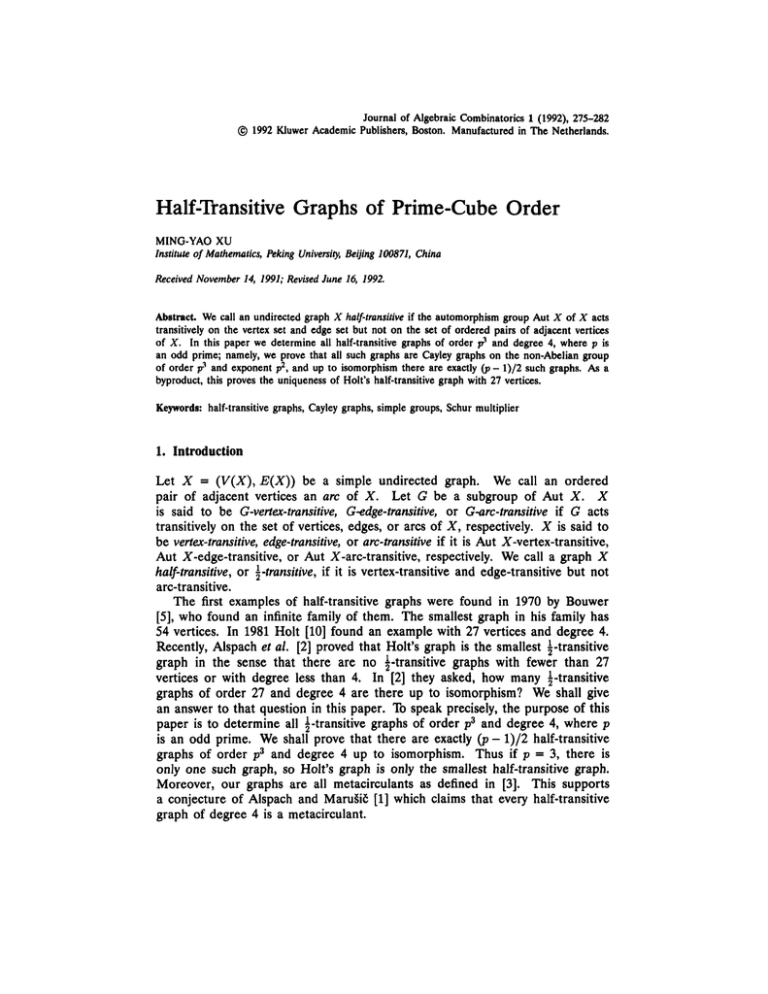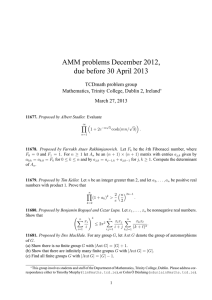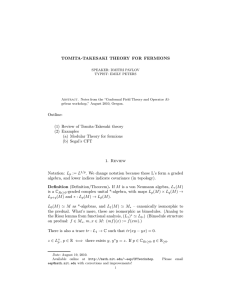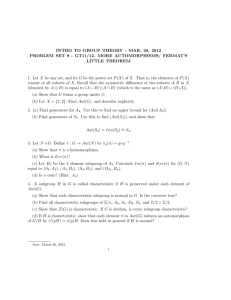Journal of Algebraic Combinatorics 1 (1992), 275-282
advertisement

Journal of Algebraic Combinatorics 1 (1992), 275-282
© 1992 Kluwer Academic Publishers, Boston. Manufactured in The Netherlands.
Half-Transitive Graphs of Prime-Cube Order
MING-YAO XU
Institute of Mathematics, Peking University, Beijing 100871, China
Received November 14, 1991; Revised June 16, 1992.
Abstract. We call an undirected graph X half-transitive if the automorphism group Aut X of X acts
transitively on the vertex set and edge set but not on the set of ordered pairs of adjacent vertices
of X. In this paper we determine all half-transitive graphs of order p3 and degree 4, where p is
an odd prime; namely, we prove that all such graphs are Cayley graphs on the non-Abelian group
of order p3 and exponent p2, and up to isomorphism there are exactly (p - l)/2 such graphs. As a
byproduct, this proves the uniqueness of Holt's half-transitive graph with 27 vertices.
Keywords: half-transitive graphs, Cayley graphs, simple groups, Schur multiplier
1. Introduction
Let X = (V(X), E(X)) be a simple undirected graph. We call an ordered
pair of adjacent vertices an arc of X. Let G be a subgroup of Aut X. X
is said to be G-vertex-transitive, G-edge-transitive, or G-arc-transitive if G acts
transitively on the set of vertices, edges, or arcs of X, respectively. X is said to
be vertex-transitive, edge-transitive, or arc-transitive if it is Aut X-vertex-transitive,
Aut X-edge-transitive, or Aut X-arc-transitive, respectively. We call a graph X
half-transitive, or 1/2-transitive, if it is vertex-transitive and edge-transitive but not
arc-transitive.
The first examples of half-transitive graphs were found in 1970 by Bouwer
[5], who found an infinite family of them. The smallest graph in his family has
54 vertices. In 1981 Holt [10] found an example with 27 vertices and degree 4.
Recently, Alspach et al. [2] proved that Holt's graph is the smallest 1/2-transitive
graph in the sense that there are no 1/2-transitive graphs with fewer than 27
vertices or with degree less than 4. In [2] they asked, how many 1/2-transitive
graphs of order 27 and degree 4 are there up to isomorphism? We shall give
an answer to that question in this paper. To speak precisely, the purpose of this
paper is to determine all 1/2-transitive graphs of order p3 and degree 4, where p
is an odd prime. We shall prove that there are exactly (p -1)/2 half-transitive
graphs of order p3 and degree 4 up to isomorphism. Thus if p = 3, there is
only one such graph, so Holt's graph is only the smallest half-transitive graph.
Moreover, our graphs are all metacirculants as defined in [3]. This supports
a conjecture of Alspach and Marusic [1] which claims that every half-transitive
graph of degree 4 is a metacirculant.
276
xu
The group- and graph-theoretic notation and terminology used here are
generally standard, and the reader can refer to [9] and [11] when necessary.
Two adjacent vertices u and v in X are denoted by u ~ v or uv e E(X). For
v e V(X), X 1 (v) denotes the neighborhood of v in X, that is, the set of vertices
adjacent to v in X.
Let G be a finite group, and let S be a subset of G not containing the
identity element 1. The Cayley digraph X = X(G, S) on G with respect to S is
defined by
If S-1 = S, then X(G, S) can be viewed as an undirected graph, identifying an
undirected edge gh with two arcs (g, h) and (h, g). This graph is called the
Cayley graph on G with respect to S. It is well known that any Cayley digraph
on G is vertex-transitive and its automorphism group contains the right regular
representation R(G) of G.
From elementary group theory we know that up to isomorphism there are
only five groups of order p3, that is, three Abelian groups Z p3 , Zp2 x Zp, and
ZpxZpX Zp, where Zn denotes the cyclic group of order n, and two non-Abelian
groups G1(p) and G2(p) defined as
and
The 1/2-transitive graphs of order p3 and degree 4 we found are Cayley graphs
on G1(p) with respect to four-element sets Si = {bia, b i a -1 , (bia)-1, (b i a -1 ) -1 }
for 1 < i < (p -1)/2. These Cayley graphs will be denoted by T i (p), that is,
Ti(p) = X(G 1 (p), Si). Holt's graph is T1(3) in our notation. Since G1(p) is
metacyclic, all Cayley graphs on G 1 (p) are metacirculants.
The main result of this paper is the following theorem:
THEOREM 1.1. The Ti(p) defined above are 1/2-transitive graphs of order p3 and
degree 4, and any 1/2-transitive graph of order p3 and degree 4 is isomorphic to a
Ti(p).
As a consequence of this theorem we have the following corollary:
COROLLARY 1.1. Up to isomorphism there is only one 1/2-transitive graph of order
27 and degree 4, namely, Holt's graph.
HALF-TRANSITIVE GRAPHS OF PRIME-CUBE ORDER
277
2. Quoted and Preliminary Results
In this section we list some quoted and preliminary results which we need in the
proof of Theorem 1.1.
LEMMA 2.1 ([12]). Any vertex-transitive graph of order p3 is a Cayley graph on a
group of order p3.
LEMMA 2.2 ([2]). Every edge-transitive Cayley graph on an Abelian group is also
arc-transitive.
LEMMA 2.3 Any edge-transitive Cayley graph on G2(p) of degree 4 is also arctransitive.
Proof. Let X = X(G2(p), S) be an edge-transitive Cayley graph on G 2 (p) with
respect to S = {x, x -1 , y, y -1 }. If (x, y) < G2(p), then every component of X
is an edge-transitive graph with fewer vertices. Thus it must be a Cayley graph
on a group of order dividing p2, hence on an Abelian group. Therefore it is
arc-transitive. Thus we may assume that (x, y) = G2(p).
It is easy to verify that x and y and also x-1 and y-1 satisfy the same relations
as do a and b. It follows that the mapping a : x —> x -1 , y i—> y-1 is an
automorphism of G2(P). Hence aR(x), where R(x) is the right multiplication
transformation by x, is a graph automorphism mapping the arc (1, x) to the
arc (x, 1). Since X is edge-transitive, X also is arc-transitive.
D
LEMMA 2.4 ([7]) . Let X(G, S) be the Cayley graph on G with respect to a subset
S, and let A=Aut X. Let Aut(G, S) = {a e Aut G\Sa = S}. Then the normalizer
NA(R(G)) of R(G) in A is the semidirect product of R(G) by Aut(G, S).
LEMMA 2.5 ([4]). Let X ( G , S) and X(G, T) be two connected Cayley graphs on
a p-group G with respect to subsets S and T, and let \S\ = \T\ < p. Then X(G, S)
and X(G, T) are isomorphic if and only if there is an automorphism a of G such
that Sa = T.
We call a group G a central extension of C by T if C < Z(G) and G/C = T.
The following result is a consequence of the finite simple group classification.
LEMMA 2.6 Assume that a non-Abelian simple group T has order 2m3np1, where
p > 3, a prime. Then l = 1, and p does not divide the order of Out T = Aut T/Inn T,
the outer automorphism group of T. Moreover, if a group G is a central extension
of C = Zp by such a simple group T, then G = CxT.
Proof. By [8, pp. 12-14] T is one of the following groups: A5, A6, L2(7), L2(8),
L2(17), L3(3), U3(3), and U4(2). Checking the atlas [6] for all groups listed
278
xu
above, we have l = 1, and p does not divide the order of Out T.
Also by [6] we have that for all these simple groups p does not divide the
order of their Schur multiplier. Then we get the last assertion of this lemma. D
LEMMA 2.7 Let G be a finite group, and let \G\ = 2m3np3. where p > 3 is a prime.
Assume that a Sylow p-subgroup P of G is non-Abelian and of exponent p2 and
that O p (G) = 1. Then P < G.
Proof (L.G. Kovacs). (i) G has no subnormal subgroup which is non-Abelian
simple, and hence OP(G) > 1: If G had such a subnormal subgroup T1 = T,
where T is non-Abelian simple, then by Lemma 2.6 p \\ \T\ and p /|Out T\. The
normal closure T1G of T1 would be generated by some G-conjugates of T1, all of
which are subnormal in G and hence in T1G. It follows that the only composition
factors of TG1 are T, and hence T1G has the form
where Ti = T is conjugate to T1 for any i. Since p3 || |G|, we have k < 3, implying
|G : N G (T 1 )\ < 3. Since N G (T 1 )/T 1 C G (T 1 ) is isomorphic to a subgroup of Out T1
and p /||Out T 1 |, we have p3 | \T1CG(T1)\. Then Sylow p-subgroups of T1GG(T1)
are also Sylow p-subgroups of G. Since T1 nGG(T1) = 1, T1CG(T1) = T1 x CG(T1).
Take P1 e Sylp(T1) and P2 € Syl p (C G (T 1 )). We have that P1 x P2 is conjugate to
P, contradicting the assumption that P is non-Abelian.
Thus we have proved that G has no minimal normal subgroup which is
insoluble, so OP(G) > 1 since Op(G) = 1.
If OP(G) = P, then P < G and we are done. Thus we may assume that
Op(G) < P. Then OP(G) has order p or p2, and hence OP(G) is Abelian. We
have the following:
(ii) C = CG(OP(G)) = OP(G): Assume that C > OP(G). First we claim that
C/Op(G) has no nontrivial normal p'-subgroup. If it had one, say, M/Op(G),
taking the complement K of OP(G) in M would produce M = OP(G) x K; then
K < Op>(G) = 1, a contradiction. Thus C/OP(G) has a normal subgroup which
is a direct product of isomorphic non-Abelian simple groups. It follows that C
has a subnormal subgroup which is a central extension of OP(G) by a simple
group T. By Lemma 2.6 this extension is a direct product of OP(G) and T.
(If |OP(G)| = p2, taking a subgroup N of OP(G) of order p, Lemma 2.6 gives
C/N = OP(G)/N x T/N, where T is a central extension of Zp by T. Then use
Lemma 2.6 again.) It follows that C, and then G, has a subnormal subgroup
which is non-Abelian simple, contradicting (i).
(iii) The completion of the proof is as follows: By (ii) G/OP(G) is isomorphic
to a subgroup of Out OP(G). If OP(G) is cyclic, then the Sylow p-subgroup
of Out OP(G) is normal, implying that the Sylow p-subgroup of G/OP(G), and
then of G, is normal, contradicting our assumption. Thus OP(G) = Zp x Zp,
and G/OP(G) is isomorphic to a subgroup L of GL(2, p). Assume that ~L =
(LCSL(2, p))/(LCZ(SL(2, p))). Then L is a subgroup of PSX(2, p), whose Sylow
HALF-TRANSITIVE GRAPHS OF PRIME-CUBE ORDER
279
p-subgroup is nontrivial and nonnormal. By Dickson's theorem [11, II.8.27] the
only subgroup with these properties is PSL(2, p) itself. Therefore L > SL(2, p).
Write R = O P ,p(G), which is defined by OP,P(G)/OP(G) = Op(G/OP(G)). We
have R > OP(G). Let Q be a complement of OP(G) in R. By the Frattini
argument G = RNG(Q) = OP(G)NG(Q). Write U = NG(Q) n OP(G), and note
that U and Q commute elementwise, so U < OP(Z(R)). Obviously, OP(Z(R)) is
normal in G. From CG(OP(G)) = OP(G) < R we know that OP(Z(K)) < OP(G).
Since L > SL(2, p), OP(G) is minimal normal in G; so the only option is that
U = 1, and therefore OP(G) is complemented in G. However, we know that
OP(G) is not complemented in P, a contradiction.
D
The final lemma gives information about the automorphism group of the
group G1(p), defined in Section 1.
LEMMA 2.8 Aut G1 (p) has order p3(p-1) and is generated by the four automorphisms
a, B, G, and G defined by
where e is an element of order p - 1 in Z*p2, the group of units in the ring Zp2 of
integers modulo p2. Moreover, we may write P - (a,B, G) and H = (p), where
P is the normal Sylow p-subgroup of Aut G 1 (p) and H is the complement of P
in Aut G1(p). Furthermore, all p-complements in Aut G 1 (p) are conjugate. In
particular, Aut G 1 (p) has one class of involutions.
Proof. Direct calculation shows that a, B, G, and G are automorphisms of G 1 (p)
and that (a,B) = Inn G1(p), the inner automorphism group of G 1 (p).
Now assume that r is an arbitrary automorphism of G1(p):aT = biaj, bT = bkas.
Since aT has order p2 and V has order p, we have p x j and p|s. Since
(bT)-1aTbT = (aT)1+p and since ap e Z(G1(P)) and G1(p) is p-Abelian, i.e.,
(xy)p = xpyp for all x, y e G1(p), we have
So j(l + p)k = j(1 + p) (mod p2), implying k = 1 (mod p). Thus we may assume
aT = b i a j , bT = batp, where i and t have at most p choices and j has p2 - p
choices. So |Aut G1(p)| < p3(p-1). However, |{a,B, G, P)| = p3(p-1), implying
Aut G1(p) ={a,B, G, P).
The remaining assertions of this lemma are obvious.
D
280
XU
3. Proof of Theorem 1.1
Let X be a 1/2-transitive graph of order p3 and degree 4. By Lemmas 2.1
and 2.3, X is a Cayley graph on G1(p) with respect to a four-element set
T = {x, x-1, y, y-1}. If X is not connected, then its components would be
Cayley graphs on a group of order p or p2, hence on an Abelian group. By
Lemma 2.2 X would be arc-transitive, a contradiction. Thus, X is connected. It
follows that (z, y) = G 1 (p).
Now we assume that X = X(G 1 (p), T) is a Cayley graph on G 1 (p) with respect
to T = {x, x - 1 , y, y-1} and that (x, y) = G 1 (p). First we shall determine the
full automorphism group A = Aut X and find conditions under which X is
1/2-transitive. All of these will be given in the following three Facts.
FACT 3.1. Aut(G1(p), T) has order at most 2, and if \Aut(G 1 (p), T)\ = 2, the
nontrivial element in Aut(G1(p), T) interchanges x and y.
Proof. Recall that Aut(G1(p), T) is the subgroup of Aut G1(p) whose elements
fix T setwise. Since (T) = G 1 (p), an automorphism of G 1 (p) fixing T pointwise
must be the identity. It follows that Aut(G1(p), T) acts on T faithfully. So
Aut(G1(p), T) is isomorphic to a subgroup of the symmetric group S4.
Further, Aut(G1(p), T) has no element of order 3. If it had such an element,
say, T, then r would have a fixed point and an orbit of length 3 in T. Assume
that x is the fixed point, i.e., XT = x. We would have that x-1, which is in the
orbit of length 3, is also a fixed point of T, a contradiction. Now we have proved
that Aut(G 1 (p), T) is a 2-group. By Lemma 2.8 Aut(G1(p), T) is a subgroup
of some p-complement conjugate to H in Aut G 1 (p). Since H is cyclic of order
p - 1, to complete the proof of this fact it suffices to prove that Aut(G1(p), T)
has no element of order 4.
Assume that a is an automorphism of G 1 (p) of order 4. a acts on T cyclically.
If xp = x - 1 , then (x -1 ) p = x, and this is not the case. So we may assume
that the action of a on T is a : x —> y —> x-1 —> y-l —> x. It follows that
xp2 = x - 1 , yp2 = y - l . Since all involutions in Aut G 1 (p) are conjugate, we may
assume that a2 e H. However, H fixes a subgroup (b), which is not in the Frattini
subgroup p(G1(p)), but a2 has no fixed subgroup of order p in the Frattini factor
group G1(p)/P(G1(p)); this is a contradiction.
The above argument also shows that if Aut(G1(p), T) # 1, then its nontrivial
element interchanges x and y.
D
For convenience, in what follows we identify the right regular representation
R(G) and G itself. The reader can infer the meaning from the context.
FACT 3.2. A = G1(p)Aut(G1(p), T) and G1(p) is the normal Sylow p-subgroup
of A.
HALF-TRANSITIVE GRAPHS OF PRIME-CUBE ORDER
281
Proof. We use A1 to denote the stabilizer of the vertex 1 in A = Aut X. Assume
that T e A1 is an element of prime order, say, q. If q > 4, then r must fix
the neighborhood X 1 (l) of 1 pointwise. By the connectedness of X, t fixes
all vertices of X; then r = 1, a contradiction. Thus q x |A1 \. It follows that
|A1| = 2m3n and \A\ = 2m3np3.
If P > 3, we have (G1(p) € Sylp(A). Since A1 is core-free, Opt(A) = 1. Then
Lemma 2.7 gives G1(p) < A and Lemma 2.4 gives A = G1(p)Aut(G1(p), T).
If p = 3 and G1(3) < Q e Syl3(A), then NA(G1(3)) > NQ(G1(3)) > G1(3).
By Lemma 2.4, NA(G1(3)) = G1(3)Aut(G1(3), T), so 3 divides the order of
Aut(G1(3), T), contradicting Fact 3.1. So we have G1(3) e Syl3(A) and \A\ = 2m33
for some m. By Lemma 2.4, to complete the proof it suffices to show that
G1(3) < A. In this case A is soluble by Burnside's famous paqb theorem [11, V.
7.3]. Since |A1| = 2m and A1 is core-free, O2(A) = 1. It follows that O3(A) > 1.
If O3(A) has a characteristic subgroup of order 3, this subgroup must be normal
in A, so it must be G1(3)', the derived subgroup of G1(3). Then we have
G1(3)'Q = QG1(3)' for all Sylow 2-subgroups Q of A. By [11, VI.6.10] A has a
normal Sylow 3-subgroup. So we may assume that O3(A) = Z3 x Z3. Since A is
soluble and O2(A) = 1, we have CU(O3(A)) = O3(A). It follows that A/O3(A) is
isomorphic to a subgroup of GL(2, 3). Now the same argument as in paragraph
(iii) of the proof of Lemma 2.7 works and gives the final contradiction.
D
The next fact is a necessary and sufficient condition for X to be 1/2-transitive.
FACT 3.3. X is 1/2-transitive if and only if Aut(G1(p), T) > 1, if and only if
Aut(G1(p), T) has order 2.
Proof. If X is 1/2-transitive, A > G 1 (p). By Fact 3.2 Aut(G1(p), T) > 1, and by
Fact 3.1 |Aut(G1(p), T)| = 2.
Conversely, if Aut(G1(p), T) = (p) has order 2, then by Fact 3.1 a interchanges
x and y. Thus the Cayley digraph X(G1(p), {x, y}) is arc-transitive. It follows
that X, the underlying undirected graph of X(G1(p), {x, y}), is edge-transitive.
Since the stabilizer A1 of A has order 2 and A has degree 4, X is not arc-transitive.
Hence X is
1/2-transitive.
D
Now we shall complete the proof of Theorem 1.1 by the following three steps:
(a) The Ti(p) defined in Section 1 are 1/2-transitive for all i: Since p(p-1)/2 e
Aut(G1(p), Si), where p is defined in Lemma 2.8, by Fact 3.3 we have that
/Xp) = X(G1(p), Si) is 1/2-transitive.
(b) Let X be a 1/2-transitive graph of order p3 and degree 4. Then X = Ti(p) for
some i: First, X = X(G 1 (p), T), a Cayley graph on G1(p) with respect to T =
{x, x-1, y, y -1 } and (x, y) = G1(p). Since X is1/2-transitive,Aut X = G1(p)(p),
where a is an automorphism of order 2 of G1(p). By Lemma 2.8 there is a
T e Aut G1(p) such that r -1 ar = p(p-1)/2, where p is defined in Lemma 2.8. Set
282
XU
y = X(G1(p), TT). It is easy to verify that Aut Y = T-1(Aut X)T = G1(p)(p(p-1)/2)
and y = X. Therefore we may assume that a = p(p-1)/2; thus ap = a-1, bb = b.
Now if x = biaj, since a interchanges x and y, we have y = bia-j and
T = {b i a j , b i a - j ,( b i a j ) - 1 , ( b i a - j ) - 1 } .Without loss of generality we may assume
that i < (p- l)/2; otherwise, we use (biaj)-1 = bp-ia-j+ijp to replace biaj. Since
(T) = G1(p), p x j, so there is an integer k such that (aj)pk = a; hence Tpk =
Si = {bia, bia-1, (bia)-1, (bia-1)-1}. Thus X(G1(p), T) = X(G1(p), Si )= Ti(p).
(c) Ti(p) # Tj(p) when 1 < i < j < (p - l)/2: If Ti(p) = Tj(p) for some i,
j with 1 < i < j < (p - l)/2, by Lemma 2.5 there exists a p e Aut G1(p) such
that Spi = Sj. Then p maps biabia-1 = b2iaiP to a product of two elements in
Sj. Note that the image of 6 under any automorphism of G1(p) is batp for some
integer t by the proof of Lemma 2.8, so (b2iaip))p = b2iakp for some k. However,
it is easy to check that the product of any two elements in Sj cannot have this
form; this is a contradiction.
Acknowledgments
The author is indebted to L.G. Kovacs for several helpful discussions about
the proof of Lemma 2.7. In fact, the proof presented here is his. This work
was supported by the National Natural Science Foundation of China and by
the Natural Science Foundation of Shanxi Province. The author thanks the
Australian National University, where he wrote this paper, for its hospitality.
References
1. B. Alspach, personal communication.
2. B. Alspach, D. MaruSit, and L. Nowitz, "Constructing graphs which are1/2-transitive," J. Austral.
Math. Soc., to appear.
3. B. Alspach and T.D. Parsons, "A construction for vertex-transitive graphs," Canad. J. Math. 34
(1982), 307-318.
4. L. Babai, "Isomorphism problem for a class of point-symmetric structures," Acta Math. Acad. Sci.
Hungar. 29 (1977), 329-336.
5. I.Z. Bouwer, "Vertex and edge-transitive but not 1-transitive graphs," Canad. Math. Bull. 13 (1970),
231-237.
6. J.H. Conway, R.T. Curtis, S.P. Norton, R.A. Parker, and R.A. Wilson, Atlas of Finite Groups,
Oxford University Press, Oxford, 1985.
7. C.D. Godsil, "On the full automorphism group of a graph," Combinatorica 1 (1981), 243-256.
8. D. Gorenstein, Finite Simple Groups, Plenum Press, New York, 1982.
9. F. Harary, Graph Theory, Addison-Wesley, Reading, MA, 1969.
10. D.F. Holt, "A graph which is edge transitive but not arc-transitive," J. Graph Theory 5 (1981),
201-204.
11. B. Huppert, Endliche Gruppen I, Springer-Verlag, Berlin, 1967.
12. D. Marusic, "Vertex transitive graphs and digraphs of order pk," Ann. Discrete Math. 27 (1985),
115-128.







